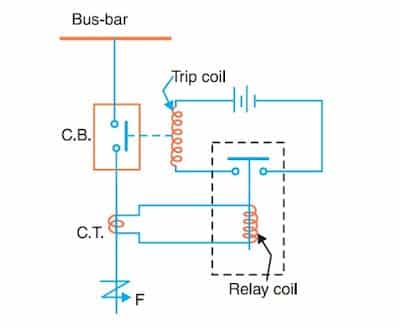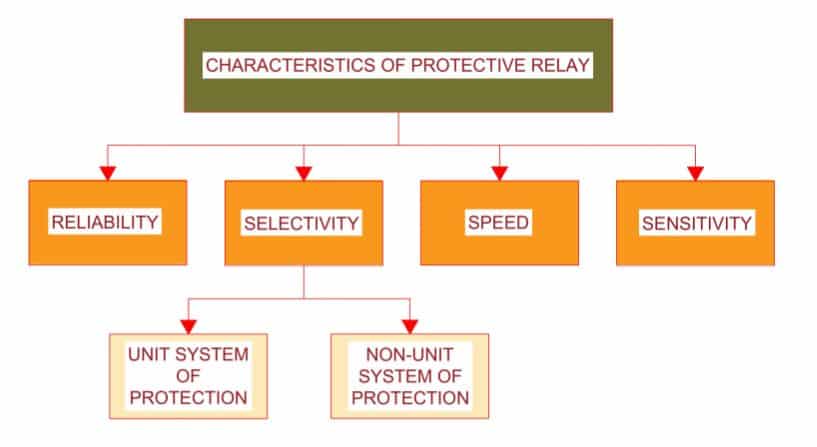A protective relay is an electrical device that monitors the voltage and current using CTs and PTs. Thus, the main function of the protective relay is to trip the breaker under abnormal operating conditions.
Principle
The protection relay compares the measured electrical quantities with the set point. If the measured quantity is more than the set point, the relay issues a trip command to the breaker.
It also generates the pre-alarm before issuing the trip command. The trip command of the relay goes to the tripping coil of the breaker. And, thus the breaker isolates the faulty section.
We use an overcurrent relay for fault detection in the electrical network. The sensing element for the overcurrent relay is the protection class current transformer. The df/dt relay monitors the frequency of the electrical network.
Therefore, the protection relay is the backbone of the electrical network. In any case, the protection relay must trip the breaker under fault conditions.
Working of Protective Relay

When the fault occurs at point F, a huge current flow in the electrical network. The current transformer(CT) senses that current and feeds into the protective relay. The relay coil of the protective relay issues a command to the circuit breaker which isolates the faulty section.
Protective Relay Characteristics
The protection relay must be reliable all the time. The protection relay must satisfy the following operational characteristics.

- Reliability
- Selectivity
- Speed
- Sensitivity
Reliability
The protective relay must be the most reliable. It should isolate the faulty part of the system from the healthy one.
Selectivity is achieved in two ways:
- Unit system protection
- Non-unit system of protection
The protection relay has many components. The reliability of the relay depends on the reliability of all the relay components.
Hence, all components and circuits involved in the operation of the relay play an important role; for example, the absence of current and voltage feeding to the relay causes unreliable operation.
The regular maintenance of the relay is a must just because the protective relays remain idle most of the time on the power system.
The reliability of the protection relay depends on the proper care of the reliable parameters at the design stage.
- Simplicity
- Robustness in construction
- High contact pressure – Ensures minimum resistance of the relay contact resistance
- Dust-free enclosures- Enhance the life of relay.
- Good contact material- Minimize resistance and no sparking during transition of the contacts
- Good workmanship.
- Careful maintenance. – Periodic maintenance ensures long life of the relay
- Timely Calibration – Calibration for accurate measurement of electrical quantities
Selectivity
Selectivity means the capability of the relay to determine the point of fault and issue of trip command to the breaker. The relay trips the nearest circuit breaker to clear the fault with minimum or no damage.
A relay should be capable to understand the equipment characteristics. For example, a transformer when energized can draw inrush current up to 20 times of rated current. In this case, both over-current and differential relay may trip.
The inrush currents have a large second harmonic content. This discriminant inhibit differential relay operation during inrush, thereby, improving selectivity in transformer protection
- Unit system protection
- Non-unit system of protection
Unit system of protection
In the unit system protection, the protection relay responds only to faults within its own defined area. The relay does not respond if the fault is outside of its area. The fault occurring at other places does not operate the protection relay. We call unit system protection zone protection or unit protection.
Examples of unit protection are differential protection of transformers, transmission lines, bus bars, and generators.
Non-unit system of protection
In non-unit type protection, the protection relay trips if the fault occurs at a different location. The protection area has no boundaries.
We can do the tripping discrimination by protection relays co-ordination.
Security
A relay is secure if it does not trip when there is no fault. Security is the degree of certainty that the relay will not operate when there is no fault.
Speed
A protection relay should clear the fault as quickly as possible to maximize safety, and minimize equipment damage and system instability. In other words, the relay must trip the nearest breaker to isolate the faulty section. This depends on the relay timing plus circuit breaker trip time. Typically, a fast circuit breaker would operate in about two cycles.
Sensitivity
A relay operation depends on the volt-amp requirement. A huge current flows when a fault is in the electrical network. The relay must be sensitive to read the current, and trips the breaker when the current exceeds above the set point.
Advantages of Protective Relay
- Protective relay continuously monitors voltage, current, frequency, power.
- Improves system stability by isolation of faulty section
- Protection relay clears the fault in no time, and thus it minimize the damage.
- The relay detects system failures, and isolate faulty sections from the rest of the system.
- It minimize the risk of fire.
- Provide electrical safety and protect person working on the system.
- Pre-alarm facilitates operator to take early action.
Applications of Protection Relay
Over-current Protection
We use an overcurrent protection relay for the protection of distribution lines, large motors, equipment, etc.
Distance Protection
The distance protection relay provides protection to Transmission or sub-transmission lines.
Differential Protection
It is used for the protection of transformers, generators, motors of very large size, bus zones, etc.
Read Next :
- Basic concepts of safety relay
- Breaking Current Capacity of circuit breaker
- Circuit breaker interview questions and answers
- Why making current is more than the breaking current?
- Use of PS class CT
- What is ANSI Device Numbers?
- Electrical Earthing, Its types & Importance